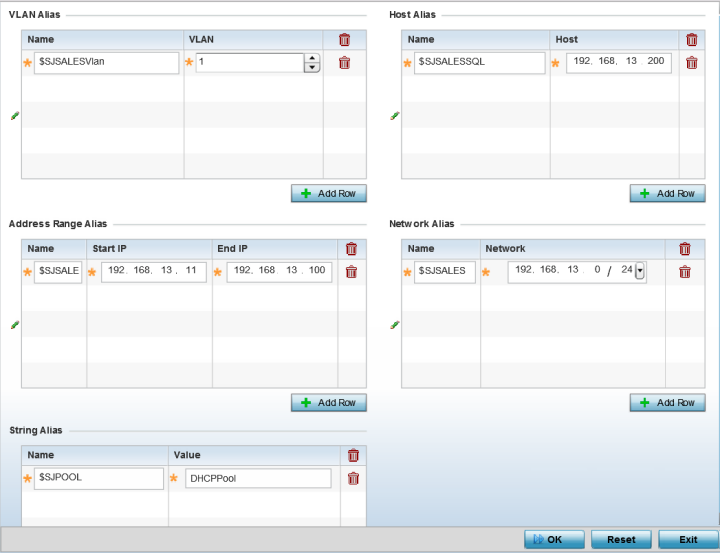Basic Alias
A basic alias is a set of configurations that consist of VLAN,
Host, Network and Address Range alias configurations. VLAN configuration is a
configuration for optimal VLAN re-use and management for local and remote
deployments. A host alias configuration is for a particular host device‘s IP
address. A network alias configuration is utilized for an IP address on a particular
network. An address range alias is a configuration for a range of IP addresses.
A basic alias configuration can contain multiple instances for each of the five (5)
alias types.
To edit or delete a basic alias configuration:
-
Go to .
-
Select an RF Domain from
the options on left-hand side of the UI, and then go to the Basic Alias
tab.
RF Domain - Basic
Alias screen
-
Select + Add Row to
define VLAN Alias settings.
-
Use the VLAN Alias field to create unique aliases for
VLANs that can be used at different deployments. For example, if a named VLAN is
defined as 10 for the central network, and the VLAN is set at 26 at a remote
location, the VLAN can be overridden at the deployment location with an alias.
At the remote deployment location, the network is functional with a VLAN ID of
26 but utilizes the name defined at the centrally managed network. A new VLAN
need not be created specifically for the remote deployment.
| Name |
If adding a new VLAN Alias, provide it a distinguishing
name up to 32 characters. The alias name always starts with
a dollar sign ($). |
| VLAN |
Use the spinner control to set a numeric VLAN from 1 -
4094. |
A VLAN alias can be used to replace VLANs in the following locations:
- Bridge VLAN
- IP Firewall Rules
- L2TPv3
- Switchport
- Wireless LANs
-
Select + Add Row to
define Address Range Alias settings.
-
Use the Address Range Alias field to create aliases for IP
address ranges that can be utilized at different deployments. For example, if an
ACL defines a pool of network addresses as 192.168.10.10 through 192.168.10.100
for an entire network, and a remote location‘s network range is 172.16.13.20
through 172.16.13.110, the remote location‘s ACL can be overridden using an
alias. At the remote location, the ACL works with the 172.16.13.20-110 address
range. A new ACL need not be created specifically for the remote deployment
location.
| Name |
If adding a new Address Alias, provide it a
distinguishing name up to 32 characters. The alias name
always starts with a dollar sign ($). |
| Start IP |
Set a starting IP address used with a range of addresses
utilized with the address range alias. |
| End IP |
Set a ending IP address used with a range of addresses
utilized with the address range alias. |
An address range alias can be used to replace an IP address range in IP
firewall rules.
-
Select + Add Row to
define Host Alias settings:
-
Use the Host Alias field to create aliases for hosts that
can be utilized at different deployments. For example, if a central network DNS
server is set a static IP address, and a remote location‘s local DNS server is
defined, this host can be overridden at the remote location. At the remote
location, the network is functional with a local DNS server, but uses the name
set at the central network. A new host need not be created at the remote
location. This simplifies creating and managing hosts and allows an
administrator to better manage specific local requirements.
| Name |
If adding a new Host Alias, provide it a distinguishing
name up to 32 characters. The alias name always starts with
a dollar sign ($). |
| Host |
Set the IP address of the host machine. |
A host alias can be used to replace hostnames in the following locations:
-
Select + Add Row to
define Network Alias settings:
-
Use the Network Alias
field to create aliases for IP networks that can be utilized at different
deployments. For example, if a central network ACL defines a network as
192.168.10.0/24, and a remote location‘s network range is 172.16.10.0/24, the
ACL can be overridden at the remote location to suit their local (but remote)
requirement. At the remote location, the ACL functions with the 172.16.10.0/24
network. A new ACL need not be created specifically for the remote deployment.
This simplifies ACL definition and allows an administrator to better manage
specific local requirements.
| Name |
If adding a new Network Alias, provide it a
distinguishing name up to 32 characters. The alias name
always starts with a dollar sign ($). |
| Network |
Provide a network address in the form of
host/mask. |
A network alias can be used to replace network declarations in the following
locations:
-
Select + Add Row to
define String Alias settings.
-
Use the String Alias field
to create aliases for strings that can be utilized at different deployments. For
example, if the main domain at a remote location is called loc1.domain.com and
at another deployment location it is called loc2.domain.com, the alias can be
overridden at the remote location to suit the local (but remote) requirement. At
one remote location, the alias functions with the loc1.domain.com domain and at
the other with the loc2.domain.com domain.
| Name |
If adding a new String Alias, provide it a distinguishing
name up to 32 characters. The alias name always starts with
a dollar sign ($). |
| Value |
Provide a string value to use in the alias. |
A string alias can be used to replace a domain name string in DHCP.
-
Select OK when completed to update the basic alias
rules. Select Reset to revert the screen back to its last
saved configuration.
